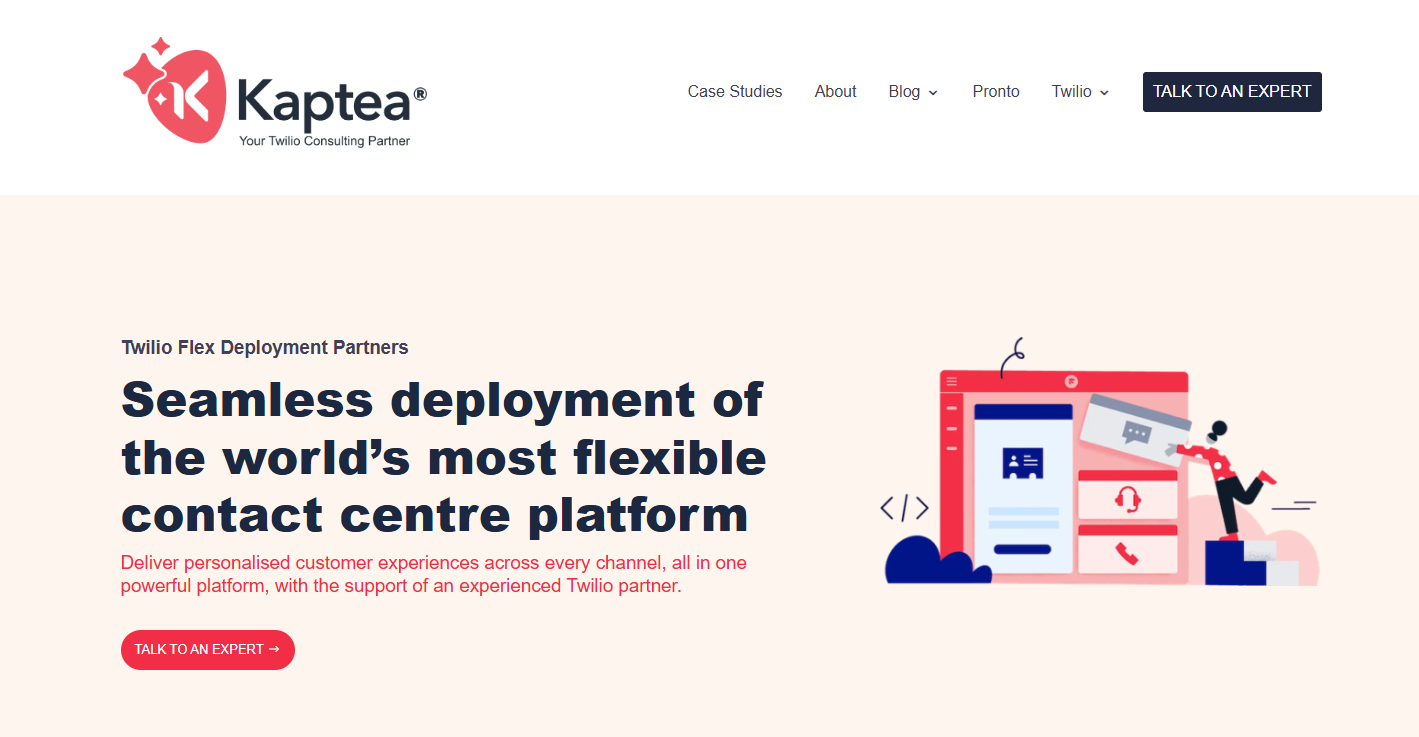
Imagine this: A customer clicks on an ad while scrolling through social media. Later, they visit the website on their laptop but don’t make a purchase. A few days pass, and they receive a well-timed email with a reminder. This time, they check out.Why did this work? Because every interaction felt connected.An omnichannel approach makes sure customers don’t feel like they’re starting over every time they switch platforms. But how do you apply this strategy to your own business?This guide explores what omnichannel marketing is, why it matters, and how businesses can use it to create better customer experiences. Let’s get started.
Omnichannel marketing is a strategy that connects every customer touchpoint, both online and offline, into a unified experience.In other words, it means giving customers a smooth, connected experience across every platform they use. Whether they visit your website, open an email, chat on social media, or walk into a store, their interactions should feel seamless and consistent.But it’s not just about showing up everywhere - it’s about making sure every touchpoint works together.Customers expect convenience. If they start a purchase on one device, they should be able to finish it on another without missing a step. Omnichannel marketing removes friction, keeps messaging aligned, and makes every interaction feel natural so customers stay engaged instead of getting frustrated.
Customers don’t follow a straight path to purchase. They browse on one device, switch to another, check reviews, and maybe visit a store - all before making a decision. If their experience feels disjointed, they’ll drop off.That’s where omnichannel marketing makes the difference. It creates a seamless journey, ensuring every touchpoint works together. Here’s why it matters:
Customers notice when things don’t match. If your website promotes a sleek, modern look, but your emails feel outdated, or your social media has a completely different tone, it creates confusion - and confusion weakens trust. Omnichannel marketing keeps everything aligned.Take Apple, for example. Whether you visit their website, open an email, or walk into a store, the experience feels the same: clean design, simple messaging, and a premium feel. That consistency reinforces their brand identity.When customers know what to expect at every touchpoint, they engage more, trust more, and stick around longer. A unified brand experience isn’t optional - it’s essential.
Ever clicked on a product, got distracted, and later seen a helpful reminder in your inbox? That’s omnichannel marketing at work. When switching between channels feels effortless, customers stay engaged instead of dropping off.People interact with brands in different ways. Some scroll through social media, others prefer email updates, and many jump between devices throughout the day. If the experience feels clunky or disconnected, they lose interest fast.But when messages feel relevant and well-timed, they’re more likely to pay attention. The easier it is to interact with your brand, the more likely they are to stick around.
Nothing kills a purchase faster than friction. If a customer adds something to their cart on mobile but doesn’t see it when they switch to desktop, chances are they won’t bother starting over.Omnichannel marketing removes those roadblocks, making the buying process smooth and effortless.When everything stays connected, customers can:
Keep this in mind: The easier it is to complete a purchase, the more sales you’ll close.
People remember experiences, especially the frustrating ones.If buying from you feels effortless, they’re more likely to return. But if they have to re-enter details, search for past orders, or struggle to reach support, they’ll look elsewhere. Omnichannel marketing removes those headaches by making every interaction smooth and connected.Think about subscription services that let you manage your account from any device without hassle. When customers know they can count on a brand to make things easy, they stick around.
Every interaction tells a story - what customers browse, where they drop off, how they engage. But if that data is scattered across different platforms, it’s hard to see the full picture. Luckily, omnichannel marketing connects those touchpoints to give you a complete view of customer behavior.When you understand how people move through their journey, you can refine your strategy. Are they opening emails but not clicking? Engaging on social media but not converting? With unified data, you can adjust messaging, improve targeting, and send the right offers at the right time.Instead of guessing what works, you’ll know. And when marketing feels more relevant, customers respond.
Omnichannel marketing isn’t one-size-fits-all. Different industries use it to create seamless customer experiences that drive engagement and sales. Here’s how it plays out across various sectors:
Shopping isn’t limited to one channel anymore. People browse online, check prices on their phones, and still visit physical stores to see products in person.A strong omnichannel strategy connects it all, letting customers check store availability online, get personalized recommendations, and pick up where they left off, no matter the device. BOPIS (buy online, pick up in-store) and hassle-free returns keep things convenient.
With omnichannel marketing, patients can schedule visits through an app, website, or phone and get automatic reminders via text or email. Telehealth services fit right into the mix, which helps make it easy to switch between virtual and in-person care without missing a beat.
Banking has to be flexible. Customers want to move between online, mobile, and in-branch services without roadblocks.Omnichannel banking makes it possible, offering real-time fraud alerts, instant support, and personalized financial advice based on their needs without making them repeat themselves across different channels.
Travelers expect a smooth experience from booking to check-in. Whether they start a reservation on their laptop and finish it on their phone or need real-time updates on their stay, omnichannel strategies keep everything in sync.Loyalty programs, instant customer support, and personalized offers help businesses keep guests coming back.
Ever started shopping on your phone, switched to your laptop, and had to start over? Or contacted support through chat, only to repeat everything on a call? These disconnects frustrate customers and cost businesses sales.Omnichannel marketing fixes this by creating a smooth, connected experience across every platform. But it’s not just about being everywhere. It’s about making sure customers can move between channels without friction, messages stay consistent, and every interaction feels like part of a bigger, well-designed journey.A solid strategy ties everything together. Here’s how to build one that actually works.
You can’t create a seamless experience without understanding how customers interact with your brand. Data is the foundation of any strong omnichannel strategy. It tells you where customers engage, what frustrates them, and how to keep them moving forward.Start by analyzing key data points:
The more you know about your audience, the better you can tailor messages, remove friction, and create a journey that feels natural.
Collecting data is just the first step; what you do with it is what really matters. A strong omnichannel strategy depends on understanding what’s working, what’s not, and where customers are getting stuck. That means looking beyond basic metrics and identifying patterns that shape the customer experience.Here’s what to focus on:
By analyzing these insights, you can refine your strategy, eliminate friction, and make every interaction feel connected. The more you understand how customers move across channels, the easier it is to create an experience that keeps them coming back.
Not all customers want the same thing or interact with your brand the same way. Some check emails daily, others live on social media, and plenty prefer a quick text over a long newsletter. A one-size-fits-all approach won’t work.You need to distinguish different customer segments so you can tailor messaging, timing, and channels to match different customer needs.Think about your audience. A first-time visitor might need a welcome offer to make their first purchase, while a repeat buyer responds better to exclusive loyalty perks.Someone who browses but never checks out might need a reminder or a limited-time discount. And if a customer always opens emails but never clicks, switching to SMS or push notifications could re-engage them.By grouping customers based on behavior, preferences, and engagement patterns, you make every interaction feel relevant.

Every interaction a customer has with your brand should feel connected, not like a series of isolated steps. Customer journey mapping helps ensure a smooth experience across multiple channels, reducing friction and keeping customers engaged.A customer might see an Instagram ad, visit your website, and leave without buying. Later, they receive an email reminding them of their interest. They return, add an item to their cart, but don’t check out.An SMS with a limited-time offer brings them back to complete the purchase. If these touchpoints aren’t aligned, customers drop off.Here’s what to consider:
A well-mapped journey removes obstacles, making it easy for customers to move from one step to the next.
Customers don’t want generic messages. They expect interactions that feel relevant to them. Personalization goes beyond using a first name in an email. It means delivering content, recommendations and offers based on past behavior, preferences, and real-time actions.A returning customer should see product suggestions that match their browsing history. Someone who abandons their cart should get a timely reminder with a small incentive. If a user prefers SMS over email, communication should reflect that.The goal is to make every interaction feel intentional, not automated.Most brands miss the mark - 61% of customers say they feel like just a number instead of an individual. When experiences feel personal, engagement goes up. Customers are more likely to open emails, return to your site, and complete purchases when they feel like the brand understands them.
A strong omnichannel strategy needs the right tools to keep everything connected. Customers expect seamless interactions across platforms, and without the right technology, things fall apart fast.The right software automates engagement, syncs data across channels, and helps maintain a smooth customer experience.Here’s what to look for:
Without the right tech, even the best strategy falls apart. The goal is a connected system that keeps data flowing across channels so customers always get the right message at the right time without friction.
If your brand feels different depending on where customers interact with it, something’s off.A sleek website means nothing if your emails feel outdated, and a polished social media presence won’t matter if customer support feels disconnected. Your brand should feel familiar and consistent across all marketing channels.When everything aligns, customers recognize and trust you. That trust leads to higher customer satisfaction, stronger engagement, and more repeat business. If people know what to expect, they feel more confident choosing you over the competition.If your branding feels scattered, now’s the time to refine it. A clear, consistent identity makes every interaction easier, more enjoyable, and more memorable. Here are some quick tips:

Mixed messages create mixed results. If your brand sounds professional in emails but overly casual on social media, customers won’t know what to expect. Confusion leads to disengagement, and disengagement leads to lost sales.Every interaction should reinforce who you are. Whether someone reads a tweet, watches an ad, or contacts support, the tone, language, and message should feel like they’re coming from the same brand. No surprises. No disconnects.Here’s what keeps messaging consistent:
Inconsistency weakens trust. Consistency builds recognition. And brands that are instantly recognizable don’t just get attention - they keep it.
Even the best omnichannel strategy isn’t perfect from the start. Customer behavior changes, platforms evolve, and what worked yesterday might not work tomorrow. The only way to stay ahead is to test, measure, and refine.Look at how customers engage. Are they opening emails but not clicking? Are Instagram ads driving traffic but not conversions? If a cart abandonment email isn’t bringing people back, tweak the subject line, timing, or offer. If SMS reminders boost engagement, double down on them.Brands that succeed don’t just launch campaigns and hope for the best. They track performance, analyze results, and adjust in real time. So, make sure to do the same for your strategy!
Omnichannel marketing only works when everything is connected - customer interactions, messaging, and support must flow seamlessly across channels. Without the right setup, businesses end up with fragmented experiences, frustrated customers, and a lot of missed opportunities.But there is one solution: Kaptea.

Kaptea can help you get the most out of Twilio by making customer communication smooth, responsive, and fully integrated. Whether it’s SMS, email, voice, or WhatsApp, we make sure Twilio fits your needs, works with your CRM, and delivers a unified experience for both customers and agents.That means no more scattered data or disconnected conversations - just a system that keeps everything in sync.With real-time analytics and expert support, you can fine-tune your approach, improve engagement, and create a customer journey that feels effortless.Talk to a Kaptea expert today and start building a stronger, more connected experience!
An omnichannel marketing strategy ensures that every customer interaction, whether online, in-store, or through a mobile app, feels seamless and connected. Unlike multichannel marketing, which focuses on using multiple platforms, omnichannel marketing integrates those platforms to provide a unified experience. This approach keeps messaging, branding, and customer data aligned, allowing businesses to deliver personalized interactions that increase engagement and customer lifetime value.
The 4 C’s of omnichannel focus on creating a connected experience for customers:
A retail brand using omnichannel marketing might connect online and offline experiences. A customer browses a product on a mobile app, adds it to their cart, then receives a personalized email reminder if they don’t complete the purchase. Later, they visit a physical store, where a sales associate can see their online browsing history and offer recommendations. This level of integration strengthens customer relationship management and improves engagement.
The 4 pillars of an effective omnichannel strategy help businesses create a smooth and connected experience:
A well-executed omnichannel strategy doesn’t just make interactions easier. It builds loyalty, drives conversions, and enhances the overall customer experience.